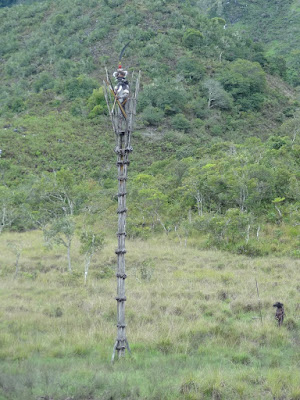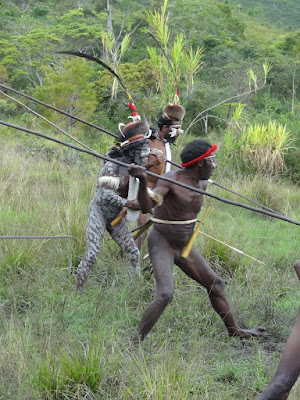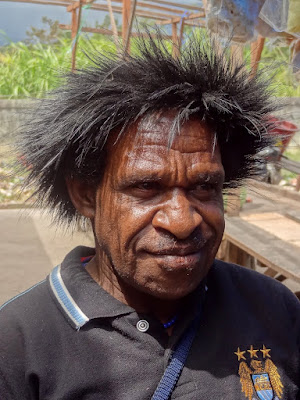Going to Baliem Valley is easier said than done. You take a night flight, spend the night on the plane since you have to fly for five and a half hours. And that from the nearest Indonesian island. I cannot even think of going to Papua directly from Turkey. It could be easier from Australia. We finally reached Jayapura, the capital city of the province. We still haven't reached our destination though. There is nothing much in Jayapura (of its colonial name Hollandia), except for the interesting fact that towards the end of the Second World War, General MacArthur gathered the American Pacific fleet here and started the attack on the Philippines, finally leading to the defeat of Japan in the Pacific.
From Jayapura we took another plane, a small one, and arrived at Wamena, the main and only town in Baliem Valley. Why go through all this trouble ? To meet the DANİ people who are Papua's largest ethnic tribe by far.
The Dani have been ''discovered'' in 1938 when the first white man, the American researcher Richard Archbold, came into the valley. (I have to note that even today, no roads lead to Baliem Valley; everything is brought by air). Until that time the local people lived in the Stone Age completely isolated from each other due to some of the most impenetrable jungles in the world, with their rituals and traditions, and having no clue that another world exists. They grew root crops, especially sweet potatoes (which is still their main crop today), raised pigs (still done today) and used polished stone instruments (which they still do). So even today, their technology has not developed much from the Stone Age; pottery is non-existent to this day, for example.
We finally reached our hotel around noon and set out to visit the Wamena market place. What a surprise! The Dani are Melanesians with dark skin and curly hair but they are the ugliest people I have ever seen in my life and that not by Western standards, but all kind of standards I would say. First of all, in some cases,I had great pain in distinguishing whether the person I was looking at was a man or a woman, if it were not for the clothes. Second, if I saw some of these men in my dreams, let alone in a dark street; believe me I would jump. But nobody should be judged by appearances, since I soon realised they are kind and smile easily.
 |
| IS THİS THE MOTHER OR THE FATHER ? |
The market itself consisted of vegetables that people sold one another and some meat stands. There was also a few fish that must have come from the small rivers dotting the valley. Several stands were selling noken, very colorful bags knitted like a net and hung on the head that each and every woman has. It serves to carry almost anything, be it goods bought at the market, sweet potatoes, bushes, wood or even a small pig. But the merchandise was poor as were the clothes worn by the people.
 |
| THE BUTCHER |
 |
| THE BUTCHER SELLS THOSE TOO |
 |
| A WOMAN WİTH HER NOKEN |
 |
| A DANİ MAN İN TRADİTİONAL CLOTHES (!) AT THE MARKET |
A typical Dani village consists of two rows of huts. On the right, you have a long one where women and children live altogether and which includes the kitchen as well, and on the left several small ones where men live, the whole area enclosed by fences made of bush with an entrance door.
What do Dani people wear ? An unmarried girl wears a thali, a skirt made of grass. After her wedding, this gets replaced by another skirt made of fibre or seeds, hung just below the abdomen and which looks very uncomfortable to carry. The breasts are uncovered; the butt never.
A horim is the only dress of naked men. A pumpkin-like fruit is hanged to dry, its interior evaporates, it is shaped with a stone while wet and once dry, the horim is ready to be worn. It is held upright by attaching a thread to the top and looping it around the waist or chest. It can be of different shape and length, some straight, some curved, some with feathers attached . On the question of why these horims, the answer is ''Dani men have always worn them''. It seems even a concerted effort by the Indonesian government failed to convince Dani men that pants were superior to horim.
To protect themselves from the cold, the only thing those people can do is to rub their bodies with a thick layer of pig fat.
 |
| CURVED |
 |
| WİTH A FEATHER AS DECORATİON |
 |
| STRAİGHT |
The Dani are divided into some thirty clans. So it is normal that conflicts arise. Nevertheless, the Dani's ritual warfare is not at all like our traditional wars. Conflicts are mostly over pig and women (in that order), with land rights coming a distant third.
Warfare consists of formal battles in designated areas as well as surprise raids. Tall watchtowers, constructed of strong poles tied together, are built to guard against those raids and can be seen outside every village. In formal battles, men wear fancy headdresses with fur and feathers of all kind, necklaces, shells and bones in their nose. The weapons employed are long pears measuring up to 4,5 meters, bows and arrows. Women watch from a safe distance bringing food and water whenever the men want to take a break. Actual fighting usually lasts ten to fifteen minutes and some ten, twelve of those clashes make up a full day's battle. Antagonists are seldom mad at each other. They just want to show off. We can say it is aggressive behavior without aggressive emotions. Even though blood is shed, death seldom occurs in Dani wars. At most, warriors can be wounded. Deaths usually come later due to infection. If such a death occurs, a cycle of revenge begins, the village being obliged to avenge its member to placate the bad spirits which otherwise would cause mischief for the whole clan. This can be done through formal wars or surprise raids, the latter lacking the fun and glory of the former.
 |
| THE WATCHTOWER |
 |
| DANİ WAR |

 |
| HEADDRESSES WORN İN FORMAL BATTLES MOST ELABORATE FOR THE VİLLAGE CHİEF. |
 |
| A DANİ MAN DEMONSTRATING HOW TO PUT A BOAR TOOTH İN THE NOSE |
Dani religion is based on spirit placation and all ceremonies are directed at winning the favor of the spirits. Funerals also are important and start with cremation to drive the ghost away from the village. Sometimes, the corpses of very important man or Kain (usually big chiefs who are charismatic individuals having risen to a position of power through success in war, the number of pigs or shells he owns, or the number of wives he can afford) were not cremated but smoked and kept in the village for supernatural reasons.
 |
| 300 YEARS OLD MUMMY OF A GREAT CHİEF |
When a close relative dies, a woman covers her body form the waist up with mud. She then puts a noken net on her head. This way, sorrow is shown. Furthermore, women, from the age of twelve, who were close to the dead person , have their fingers amputated up to the second phalanx. This cruel ritual starts with the little finger of the left hand and with each death the woman will be one phalanx shorter. Nevertheless, not to prevent women from carrying out their daily chores, the thumb always remains complete. The amputation is done in full consciousness with a stone knife. The wound is then bandaged with healing herbs and covered with a banana leaf. For the rest of the day, the girl or woman sits with her hand pointing up so that the bleeding will stop. The cut finger parts are left to dry, burned, and the ashes are buried in a special place. Cutting the fingers is necessary for calming the spirits. When a woman dies, nothing happens to the close male relative, of course. I would have been surprised if it did. So in this respect, nothing changed much since the Stone Age it seems. The burden is always on the woman.
Although the cutting of fingers is no longer practised, one can still see many older women with missing phalanxes.
And that is not only it. Dani women have other defaults as well. Men believe women suck their manhood from them and they are thus weakened. They believe they must avoid women. But they have to reproduce too. So the rule is quite simple : no sex for five years after a child is born. It is a big shame to have a woman pregnant again before the five years are up. Thus not many Dani women have more than two children which could be considered as the only advantage of this practice. Of course, during the five-year abstinence period, the man brings home other wives, the number depending on his wealth, itself determined by the number of pigs he owns. Polygamy is thus still widespread among the Dani. It is the pig that determines the value of a woman and as many as five pigs can be given for a good wife. What is a good wife according to a Dani man ? Beauty is not a concern at all; what is important is her strength and ability in taking care of the pigs, children and fields (in that order).
Segregation also shows itself in the fact that during rituals, women sit separately. In general, only men are allowed to eat meat and the women can only taste it during wedding ceremonies.
You never go on a visit without a present. So we brought our present while going to the village. Our present was a pig, a piglet in fact, since our local guide informed us that would be enough since we were only three people. He organised for the piglet to be brought to the village of course. Let me now narrate the story of our little pig.
The fate of our piglet was to be eaten of course. So first it has to be killed . Two men hold it while the chief takes his bow, sends an arrow straight into the heart of the animal which dies at once, not even having been able to shriek.
Since the pig is going to be cooked, we need a fire. To light one is not that easy. With bare feet, a man rises on a wooden block. He starts pulling a rattan runner that quickly slides on the wooden block under which there is some straw. After intense sliding, smoke starts to appear and the straw catches the sparkles. Then the chief starts blowing on the straw and the first flames appear. We have witnessed the lighting of a fire as done thousands of years ago.
These flames are used to light a fire on which the piglet is first smoked to get rid of all its hair. Now is time to cut the animal to pieces and a bamboo knife has appeared . The animal is opened into two with a single clean cut starting from the mouth, continuing through the abdomen and between the legs as far as the anal orifice.
At the same time, a hole in the earth, next to the fire is being filled with leaves. Then stones that have been heated in the fire are brought with tongs and cover the leaves, themselves being covered by a second layer of leaves.
Now the women have returned from the fields carrying sweet potatoes. Those are put on the leaves, themselves covered with hot stones, and leaves again. The whole thing is then covered with banana leaves. It is time to bring the meat.
Now the villagers do not have much left to do so they start taking interest in their guests. In Dani language, ''wa'' means, hello, welcome. The more wa your interlocutor says, the more welcome you are. So men all started paying visits to a little cabin they had opened for us to put our bags and rest a bit if we wanted to. It was very thoughtful since we stayed in the village for at least four to five hours and sitting from time to time felt good. Anyway, we had guests in our little cabin, lots of men (but strangely enough not one single woman) came to us with their arms wide open saying ''wa,wa,wa,wa,wa'' , giving us a handshake (which is very common in Papua) and kissing us on both cheeks (I do not know if this is so common or they were taking advantage of the situation). It is in this little village that I have been kissed by some of the ugliest men on this planet. Can this be considered as an honor ?
 |
| HE İS NOT GOİNG TO EAT ME, İS HE ? IT İS JUST A KİSS. |
And I fell in love in Papua, in this little village. He was very handsome, even though with kind of crooked legs. I really wanted him to come to Turkey with me , but no way. My heart broke and I had to leave my new love in Papua.
As to the funny part of it, according to official Indonesian statistics, 99% of Papuans are Christian. It is true missionaries came here too, and believed they had converted the Dani. But conversion to a poorly understood Christianity , if it happened, was mainly on paper. Can we say this is the revenge of the Dani? There is only one plain truth when you go to Baliem Valley and spend some time with the Dani: Baliem Valley and its people are the last bastion of the Stone Age in all its glory.



















































No comments:
Post a Comment